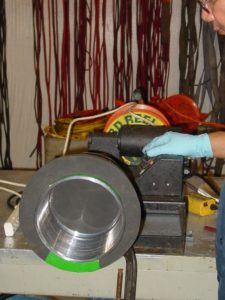
With any brush plating application, controlling the variables of the process is essential to achieving a high quality, adherent deposit. The operator directly controls several plating variables in the selective plating operation that can affect the quality of the deposit. They are the voltage, amperage (current density), anode-to cathode speed, solution flow rate, uniformity of solution distribution at the work area, solution temperature, plating tool contact area and cover material.
The selective plating process requires movement between the plating tool (anode) and the part. This movement is called the anode-to-cathode speed, and is measured in surface feet per minute. The plating tool can be moved over the part, the part can be moved with the plating tool stationary, or there can be a combined movement. For easy reference when starting your application, the anode-to-cathode speed is listed in the technical data sheet of the plating solution.
If the part is being rotated in a lathe, the desired anode-to-cathode speed is converted into revolutions per minute (RPM). The formula to determine RPM when rotating the workpiece in a lathe is:
RPM = (FPM x 3.82)/D
Where
RPM = revolutions per minute at which the part or tool should be rotated.
FPM = recommended anode-to-cathode speed, in feet per minute, for the plating solution used.
D = diameter, in inches, of the OD or ID to be plated.
For Example:
FPM = 50
D = 6”
Placing these values in the above formula:
RPM = (50 x 3.82)/6 = 31.8
The spindle speed of the lathe should be set to the closest value of the calculated RPM as possible. But, in some applications, it may be difficult or even impossible to achieve the recommended anode-to-cathode speed with or without a lathe. In those cases, tests have shown that a change in the current density can compensate for the inability to use the optimum anode to cathode speed.
In the event the closest speed available on the lathe was 75 RPM, the current density could be adjusted as follows:
CDa = CDo x 3Ö (Sa ÷ So)
Where
CDa = Adjusted Current Density
CDo = Current Density at Optimum Anode-to-Cathode Speed
Sa = Actual Anode-to-Cathode Speed
So = Optimum Anode-to-Cathode Speed
For Example:
CDo = 7 amps/in2
Sa = 117 FPM
So = 50 FPM
Placing these values in the formula above:
CDa = 7 x 3Ö (117/50) = 9.29 amps/in2
Moderate deviations of 10 to 15 feet per minute should have no noticeable impact on the deposit (assuming all other all process variables are in control). But no movement or insufficient movement, even if momentary, may result in burning.
Sustaining the proper anode-to-cathode speed together with maintaining the other variables ensures a consistent, uniform, and adherent deposit. If you need assistance maintaining your anode-to-cathode speed, or calculating RPM or CDa, please contact our technical service representatives at info@sifcoasc.com or 800-765-4131.

 Chinese (Simplified)
Chinese (Simplified)  English
English  French
French  German
German  Spanish
Spanish  Swedish
Swedish 